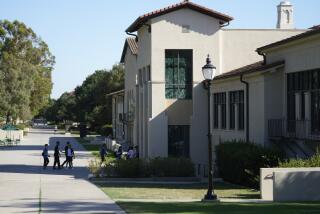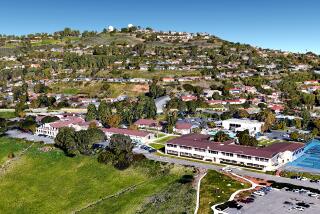O.C. community college to sell its Canadian isle
- Share via
A Costa Mesa community college has decided to sell its craggy British Columbia island over the protests of students and faculty who had hoped to transform the ecologically delicate parcel into a field research station.
The Orange Coast College Foundation Board of Directors voted 15-1, with one abstention, on Thursday to proceed with the sale of Rabbit Island, a 36-acre swath in the Gulf Islands, which dot the Strait of Georgia off of Vancouver.
For the record:
12:00 a.m. March 17, 2007 For The Record
Los Angeles Times Saturday March 17, 2007 Home Edition Main News Part A Page 2 National Desk 1 inches; 47 words Type of Material: Correction
Island sale: In some editions of Thursday’s California section, an article about Orange Coast College’s decision to sell Rabbit Island in British Columbia said that marine science faculty had received a grant from the National Science Foundation. The grant was received by marine science and biology faculty.
The vote allows the college to retain a broker for the sale of the island, which is worth about $1 million and could be put on the market as early as May. It typically takes at least a year to sell an island, Canadian real estate agents said, though several interested buyers have already contacted the college.
The decision comes after a lengthy campus debate in which some faculty members argued that Rabbit Island affords the college a unique research opportunity. Students circulated petitions that said selling the island “for a quick cash boon would be a hasty and unwise use of a generous gift.”
The board’s sole dissenter, Mary Lynn Bergman-Rallis, said her vote “reflected my passion rather than the bottom line.”
“I was so inspired by the beauty,” said Bergman-Rallis, who has visited the island. “You’re taken out of your busy urban life and plopped into an amazing place.”
Long Beach sailor Henry Wheeler donated Rabbit Island to the college in 2002 after using it for nearly a decade as a family vacation retreat. He had tired of the long treks to the property, which he bought in 1993 for $319,000 Canadian. He had previously given a boat to the college’s School of Sailing and Seamanship.
The college promised to keep the rugged property, thought to be named for its resemblance to a crouching rabbit, for at least two years. If the island is sold, the proceeds will go to the college’s sailing school, according to the donation agreement.
Wheeler has said that although he was disappointed that students wouldn’t be learning on his former island, he respected the college’s decision.
The college, which has an enrollment of about 24,000, held classes on the island each summer for about 25 students, who combed it for plant samples and snapped photos of spectacular tides. They stayed in four cabins equipped with twin beds, sinks and mirrors; the island also has a solar generator, a windmill, several bathrooms and an outhouse carved with the requisite crescent moon.
The college plans biology, ecology and geography classes there this summer.
While caretakers oversaw the property during stormy winter months, the distance between the island and the college -- almost 1,300 miles -- proved too much to overcome.
Repair costs topped $200,000, and the island’s annual budget climbed to $75,000. Foundation trustees began mulling whether to keep the island last fall. Recently hired consultants concluded that the island was too far away and its maintenance too expensive to make a research station feasible.
*
More to Read
Sign up for Essential California
The most important California stories and recommendations in your inbox every morning.
You may occasionally receive promotional content from the Los Angeles Times.












